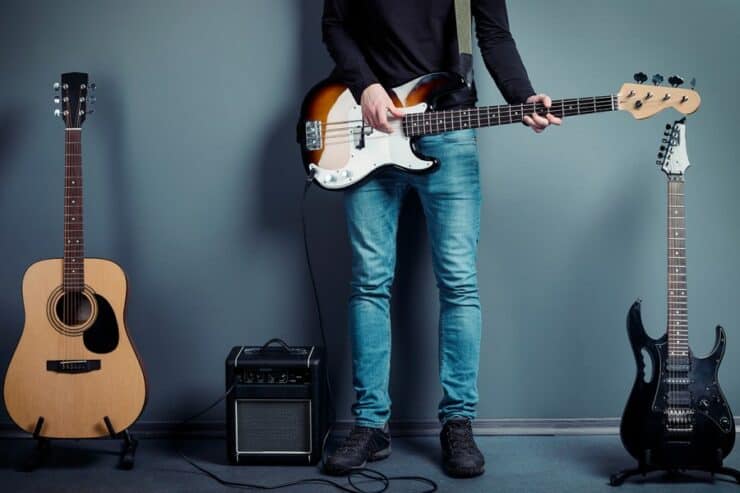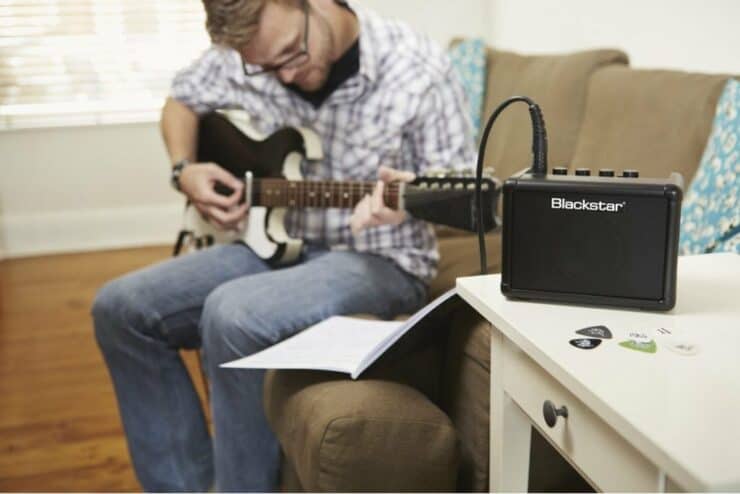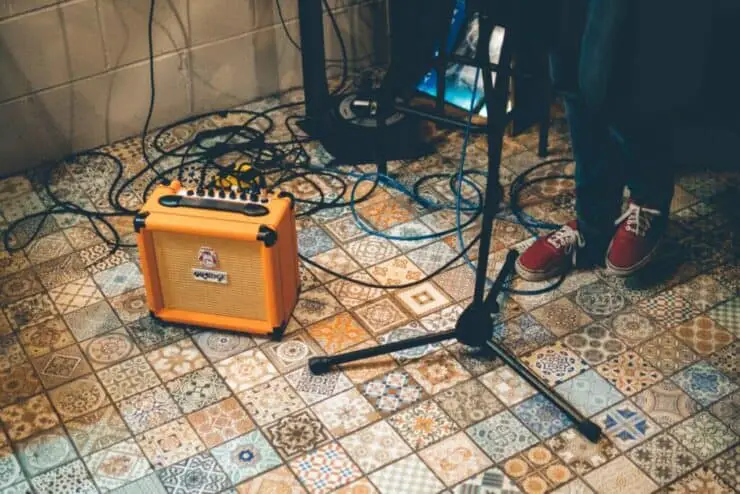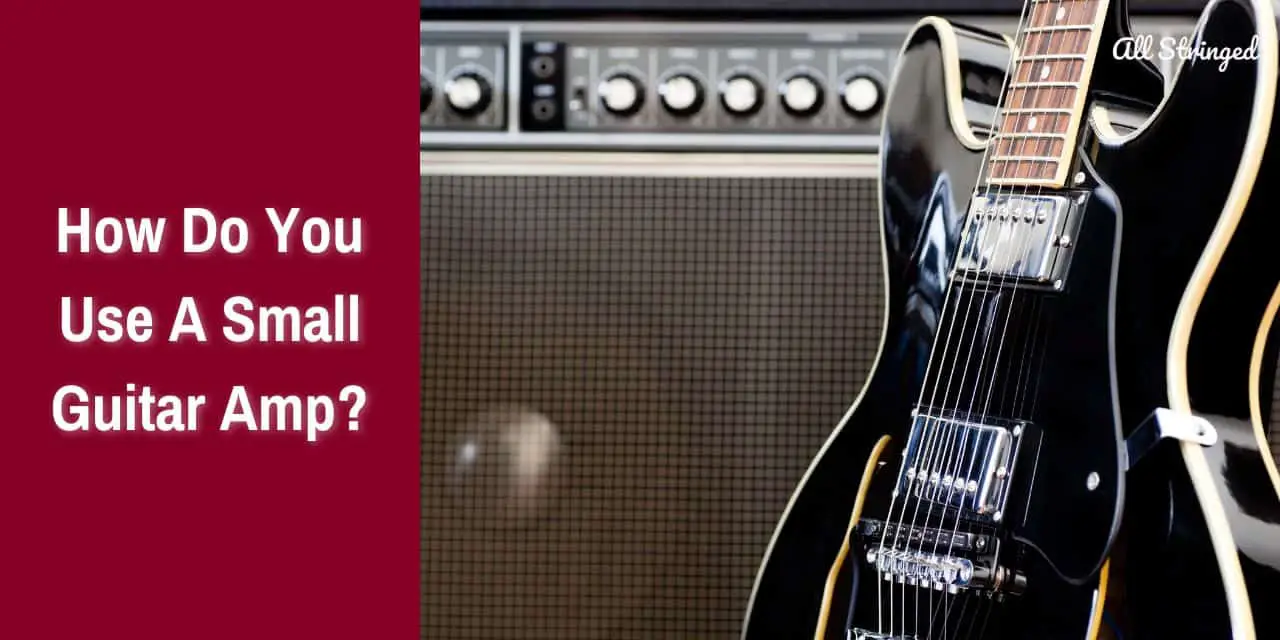Playing guitar is an enjoyable experience, and having the right gear to get the best sound out of your instrument is essential. Have you ever heard someone play guitar through a small amp and wondered how they make it sound so good? In this article, we will take a look at how to use a small guitar amp to get the best sound out of your playing. Whether you’re a beginner or a seasoned guitarist, this article will provide you with tips and tricks to get the most out of your amp. So, if you’re ready to learn how to use a small amp to create the perfect sound, let’s get started!
What do you mean by a small guitar amp?
Whether you are a musician or a guitarist, finding the right gear will be important for crafting the desired sound. When it comes to guitar amps, there are a wide variety of options available, ranging from massive stacks to compact combos. Small guitar amps have become a popular choice among musicians. A small guitar amp offers a whole host of benefits for both beginners and seasoned veterans. However, what do you actually mean by a small guitar amp?
>>> Click here to read our review about the Top 15 Best Small Guitar Amps <<<
A small guitar amp refers to a compact amplifier designed specifically for electric guitars. It is typically lightweight, portable, and easy to transport, making it an ideal choice for musicians on the go. While the specific size might vary, small guitar amps are largely characterized by their reduced dimensions compared to larger and more powerful amps.
Benefits of a small guitar amp
While larger and more powerful amps might seem enticing, small guitar amps also come with a whole host of unique advantages that shouldn’t be overlooked. Knowing these benefits will come in handy. Whether you are a beginner, a traveling guitarist, or someone looking for a convenient practice session, a small guitar amp might be the ideal option for enhancing your musical journey. Here, you will get to know some of the primary benefits of using a small guitar amp.
#1. Portability and convenience
One of the most notable benefits of a small guitar amp is its portability. These compact amps are designed to be lightweight and quite easy to transport, making them perfect for musicians on the go. Whether you are headed for a jam session, a small gig, or just want to practice in a remote location, a small guitar amp can be carried from one place to the other effortlessly.
Many small guitar amp models come with built-in handles, making them quite convenient to transport. Their compact size also means that they consume less space. This makes them suited for small practice rooms or cramped living spaces.
#2. Versatility and performance
Contrary to their size, small guitar amps pack a surprising amount of versatility and performance. Many models offer multiple channels, allowing you to easily switch between different tones or effects with ease.
Some amps also include built-in digital effects like reverb, delay, or modulation, expanding your sonic possibilities. Moreover, small guitar amps often feature tone controls that allow you to shape your sound to suit your preferences and musical style. These versatile features make small guitar amps suited for a wide range of genres, from rock to jazz to pop.

#3. Practice and home use
For beginners and practicing musicians, a small guitar amp is a tremendous choice. Their lower wattage output will allow you to have quieter practice sessions without sacrificing tone or quality. Many small amps feature headphone jacks, allowing you to practice silently without disturbing other people.
This is highly beneficial for late-night practice or living in shared spaces. Moreover, some models come with auxiliary inputs, allowing you to connect your smartphone or music players to play along with your favorite tracks. The ability to practice effectively and comfortably at home will be a significant advantage of small guitar amps.
#4. Cost-effectiveness
Small guitar amps are often more affordable compared to larger, high-powered amps. This cost-effectiveness makes them a highly attractive option, especially for beginners or musicians on a budget. Despite their lower price range, many small amps offer impressive sound quality, reliable performance, and a range of features that ensure an enjoyable playing experience.
With a small guitar amp, you will be able to acquire a quality amp without breaking the bank. This will allow you to allocate your resources to other musical equipment or lessons.
How do you use a small guitar amp?
Setting up and adjusting a small guitar amp properly is important for achieving the ideal tone and maximizing your playing experience. While small guitar amps are compact and straightforward, understanding the setup process and how to adjust them will greatly enhance the sound. Here, you will get to know how do you use a small guitar amp by setting it up and adjusting it effectively.
Step 1: Position your amp
Begin by finding the optimal placement for your small guitar amp. Ideally, you will want to place the amp on a stable surface at ear level, allowing you to hear the sound clearly.
Avoid placing the amp directly on the floor as it could impact the sound projection and make it tricky to access the controls. You must position the amp away from walls or objects that can interfere with sound dispersion. You should experiment with different placements to find the sweet spot where the amp sounds its best.
Step 2: Connect your guitar
Next, you need to connect your guitar to the amp via a high-quality instrument cable. Plug one end into the guitar’s output jack and the other into the input jack of the amp.
You should make sure that the cable is securely connected to avoid any signal loss or unwanted noise. If the amp has multiple input options, such as high and low gain, experiment with them and find the perfect match for your guitar’s output.
Step 3: Adjust the volume and gain
Once the guitar is connected, you should start by setting the volume and gain controls on the amp. Begin with both controls set to their minimum or at a low level to prevent any sudden loud noises.
Then, you should gradually increase the volume to the desired level, making sure it is loud enough to hear but not overpowering. The gain control will adjust the amount of distortion or overdrive in your sound. You can experiment with different gain settings to find the right balance that suits your musical style and preferences.

Step 4: Tone controls and equalization
Most small guitar amps include tone controls or equalization options for shaping the sound further. They typically consist of bass, treble, and mid knobs. You should start off with the knobs set to their mid-point or neutral position and make adjustments based on your preferences.
Boosting the bass will add warmth and depth whereas increasing the midrange will provide more presence and punch.
Adjust the treble to add brightness and clarity to the sound. Experiment with different settings until you get a tone that suits your playing style and the music you are performing.
Step 5: Effects and additional features
Many small guitar amps come with built-in effects like delay, reverb, or modulation. If the amp includes these features, you must familiarize yourself with the controls and experiment with different settings toad depth and ambiance to the sound. Adjust the effects levels to your preferences, ensuring they enhance your playing without overpowering the overall tone.
Step 6: Fine-tune and experiment
Once you have set the basic parameters, you should spend some time fine-tuning and experimenting with your small guitar amp.
Play different chords, riffs, and solos for evaluating how the amp responds and adjust accordingly. Take note of any adjustments you’re making and the impact they have on the sound. This process of exploration will help you develop a better understanding of your amp’s capabilities and how to get the best out of it.
How do you use a small guitar amp for practice and live performances?
A small guitar amp is an extremely versatile tool that enhances your practice sessions and comes in handy during live performances when using a large guitar amp isn’t an option. Whether you’re honing your skills in your bedroom or rocking out on stage, knowing how do you use a small guitar amp for practice and live performances will be helpful.
Use the small amp for practice
First, you need to select a quiet and comfortable space for your practice sessions. Ideally, you should set up your guitar amp in a room where you don’t disturb others or be easily distracted. You should consider using your headphones for silent practice, especially when playing late at night or in shared living spaces. This will allow you to focus solely on your playing without external distractions.
Then, you should set the amp’s volume at a reasonable level for practice. Start at a lower volume to prevent overwhelming yourself and adjust it as needed. The goal will be to find a balance where you can clearly hear your playing without causing discomfort or fatigue. You should remember that the purpose of practicing with a small guitar amp is to refine your technique. You need to focus on clarity and accuracy instead of volume.
You should also be experimenting with tones and effects. Small guitar amps feature built-in tone controls and effects. You should take the opportunity to experiment with different settings and effects to shape your sound.
Adjust the bass, mid, and treble controls for achieving the perfect sound. Gradually introduce effects like delay, reverb, or modulation for enhancing your playing. However, you must remember that the goal of experimenting with effects is to develop control and improve your overall performance.
Using the amp for live performance
Before a live performance, you should ensure that the amp is in good working condition. Check all cables and connections, ensuring that they are secure and free from any damage. Test your amp’s functionality by playing it to ensure it is delivering the ideal sound. You should also carry the necessary spare cables or accessories to handle unforeseen circumstances.
Arrive early at the venue and set up your gear and conduct a thorough soundcheck. Position your guitar amp on stage in a suitable location that allows for proper sound projection and stage presence. Communicate with the sound engineer to make sure your amp’s output is balanced within the overall mix. Make the necessary adjustments to the volume, tone, and effects to accommodate the specific acoustics of the venue.
When performing, you should be mindful of the amp’s volume. Adjust it according to the venue’s size, the band’s dynamics, and the requirements of the music you are playing. Pay close attention to your playing technique and maintain consistency in your performance. Utilize the tone controls and effects on your amp for adding depth and character to your sound, enhancing the overall stage presence.
Use your small guitar amp for amplifying your stage presence by adjusting volume swells, feedback, or controlled distortion. Be attentive to the crowd’s response and adjust your playing and amp’s settings accordingly. This will help you create a more immersive and captivating experience.
Tips to get the most out of a small guitar amp
Small guitar amps might have limitations in terms of size and power. However, there are different techniques and strategies that you can employ to get the most out of your small guitar amp. Here are some key tips that will help you maximize the performance of your small guitar amp. By implementing these tips, you’ll be able to unlock a world of possibilities and achieve a larger-than-life sound from your small guitar amp.
Choose the right speaker size
The size of the speaker in your small guitar amp plays a major role in shaping your tone and sound projection. While small amps generally come with speakers ranging from 6 to 10 inches, selecting the right size can make a noticeable difference.
6-inch speakers are ideal for practice and personal use. They provide a focused and intimate sound and excel in small spaces and deliver a tight, punchy response. Meanwhile, 8-inch speakers offer a balanced mix of portability and sound projection. They strike the right balance between clarity and low-end presence. They are suitable for small gigs or rehearsals with other musicians.
With a larger size, 10-inch speakers offer more low-end response and increased volume capability. They are well-suited for live performances and can fill larger venues with their enhanced projection.
You must consider the intended use and environment when choosing the speaker size for your guitar amp. Experimenting with different sizes will help you find the perfect match for your playing style and specific needs.
Use different effects
Small guitar amps come equipped with built-in effects that can enhance your sound and add depth to your performance. Understanding how to properly utilize these effects effectively can take your play to new heights. Some of the common effects in a small guitar amp include reverb, delay, and modulation.
Reverb is an effect that adds a sense of spaciousness and natural ambiance to your sound. It simulates the reverberations of different room sizes. You need to experiment with the reverb settings to create a sense of depth and dimensionality in your playing.
Delay creates repetitions of your guitar signal, adding a subtle echo effect. You should use it to enhance solos, create atmospheric textures, or achieve rhythmic patterns. Adjust the delay time and feedback settings for achieving the desired effect.
Modulation effects like chorus, flanger, and phaser can add movement and character to your sound. These effects alter the pitch, phase, or frequency of your signal, creating a unique and captivating sonic landscape.
You should experiment with different combinations of effects and settings to find the perfect balance that complements your playing style and the music you are performing.
Use the power of a microphone
To further enhance the capabilities of your small guitar amp, you must consider using a mic to capture and amplify your sound. By doing this, you’ll be able to overcome any volume limitations and project your guitar’s tone to a bigger audience. There are two types of microphones available in the market – Dynamic and condenser microphones.
Dynamic microphones are commonly used for small guitar amps due to their durability and ability to handle high sound pressure levels. You must position the mic close to the amp’s speaker cone to perfectly capture the best representation of your amp’s sound.
Condenser microphones are more sensitive and offer a higher level of detail and accuracy. They are perfect for recording applications or situations where a more nuanced sound capture is needed.
You should try to experiment with microphone placement for finding the sweet spot that captures the desired tonal characteristics of your small guitar amp. You can also consider using microphone stands or microphone mounting systems to ensure stability and consistency in your live performances or reading sessions.

Different types of small guitar amps
Small guitar amps offer a portable and convenient solution for musicians and guitarists who are after a great tone without having to sacrifice mobility. Despite their minimal size and compact nature, these amps come in different types. Each type of small guitar amp comes with unique characteristics and sonic capabilities. Here are the different types of small guitar amps and their features to help you choose the perfect amp for your musical needs.
#1. Solid-state amps
Solid-state amps are the most commonly used type of small guitar amps. They use solid-state electronics such as transistors for amplifying the guitar signal. They are known best for their affordability, reliability, and consistent performance.
These amps typically deliver clean and crisp tones with an excellent note definition. They are suitable for music genres like country, jazz, and clean rock. These amps are lightweight, which makes them ideal for practice sessions, small gigs, and home use. They often come with multiple channels and built-in effects for versatility.
#2. Tube amps
Tube amps or valve amps use vacuum tubes for amplifying the guitar signal. They are revered for delivering warm and organic tones and rich harmonics and dynamic responses. Tube amps excel at producing natural overdrive and distortion, making them a favorite among blues, rock, and classic rock guitarists.
Despite their larger counterparts being more common, there are smaller tube amps available that manage to retain the same tonal qualities. Tube amps can be louder and heavier than solid-state amps. Moreover, they also offer unmatched sonic character and responsiveness.
#3. Digital modeling amps
Digital modeling amps use digital technology for simulating the sound characteristics of various amps, cabinets, and effects. They offer a wide range of amp models and effects, allowing musicians and guitarists to experiment with different tones and styles.
These amps can accurately emulate the sound of solid-state amps, tube amps, and even specialized boutique amps. They’re incredibly versatile and come with built-in features like USB recording capabilities and headphone outputs for silent practice. Digital modeling amps by brands like Marshall, Line, and Boss are ideal for players who are after versatility and want access to a multitude of tones in a single unit.
FAQs
What is a small guitar amp and what are its benefits?
A small guitar amp is a compact amplifier designed for practice and home use. These amps are typically lightweight and portable, making them easy to transport and store. They also usually have lower wattage and speaker size compared to regular amplifiers, which makes them better suited for practice and home use where higher volumes may not be practical.
How do I set up and use a small guitar amp?
Setting up and using a small guitar amp is fairly straightforward. Most amps come with a power cable and speaker cable, and will require some basic assembly. Once the amp is assembled, you can simply plug your guitar into the input jack and adjust the volume and tone to your preference. Many amps also come with headphone jacks, allowing for silent practice.
What are some tips for getting the best sound out of my small guitar amp?
To get the best sound out of your small guitar amp, it’s important to adjust the volume and tone settings to your preference. You may also want to experiment with different types of amps, as each type has its own unique sound. Finally, it’s important to make sure the amp is in good condition by regularly checking the speaker, power cable, and other components for



